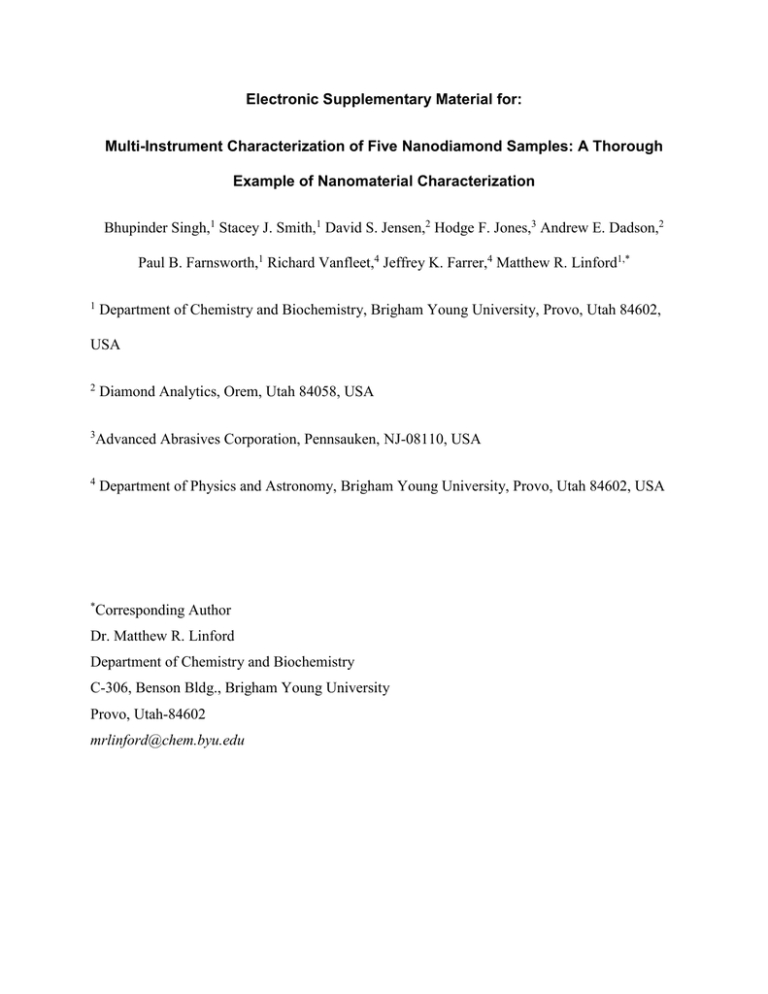m/z 246 247 248 249 250 251 - Springer Static Content Server
advertisement

Electronic Supplementary Material for: Multi-Instrument Characterization of Five Nanodiamond Samples: A Thorough Example of Nanomaterial Characterization Bhupinder Singh,1 Stacey J. Smith,1 David S. Jensen,2 Hodge F. Jones,3 Andrew E. Dadson,2 Paul B. Farnsworth,1 Richard Vanfleet,4 Jeffrey K. Farrer,4 Matthew R. Linford1,* 1 Department of Chemistry and Biochemistry, Brigham Young University, Provo, Utah 84602, USA 2 3 4 Diamond Analytics, Orem, Utah 84058, USA Advanced Abrasives Corporation, Pennsauken, NJ-08110, USA Department of Physics and Astronomy, Brigham Young University, Provo, Utah 84602, USA * Corresponding Author Dr. Matthew R. Linford Department of Chemistry and Biochemistry C-306, Benson Bldg., Brigham Young University Provo, Utah-84602 mrlinford@chem.byu.edu Supporting Information Fig. 1 XPS survey scans of (a) unwashed and (b) double washed AA samples Supporting Information: WO3 and WO4 assignments to negative ion ToF-SIMS spectra The negative ion ToF-SIMS analysis of the nanodiamond samples is shown in Fig. 2 (in the paper). We observe two peak envelopes. The first peak envelope contains six peaks positioned at m/z 230 to m/z 235, and a second envelope has six peaks positioned from m/z 246 to m/z 251. Initially, based on molecular weight estimates, the peak envelopes were attributed to WO3- and WO4H-, respectively. To confirm that we were making reasonable assignments, we looked at the tungsten isotopes and their ratios. The following table gives the most stable tungsten isotopes. Tungsten (W) isotopes Relative Abundance 182 W 26.50% 183 W 14.31% 184 W 30.64% 186 W 28.43% Looking at the isotopic ratios of tungsten, it becomes clear that the initial assignment to the peak envelopes of WO3- and WO4H- did not explain the peaks at m/z 233 and 235 in the proposed WO3- envelope and the peaks at m/z 246 and 250 in the proposed WO4H- envelope. The next hypothesis was that the peak envelopes were a contribution of peaks due to WO3- and WO3H-, and WO4- and WO4H-. To prove our hypothesis, we calculated the contributions of each peak using the following equations. (𝐼230,𝑊𝑂3 ) + (0) = 𝐼𝑇𝑜𝑡𝑎𝑙,230 (𝐼231,𝑊𝑂3 = 𝐼230,𝑊𝑂3 ∗ 14.31 ) + (𝐼231,𝑊𝑂3𝐻 ) = 𝐼𝑇𝑜𝑡𝑎𝑙,231 26.50 (𝐼232,𝑊𝑂3 = 𝐼230,𝑊𝑂3 ∗ 30.64 14.31 ) + (𝐼232,𝑊𝑂3𝐻 = 𝐼231,𝑊𝑂3𝐻 ∗ ) = 𝐼𝑇𝑜𝑡𝑎𝑙,232 26.50 26.50 (𝐼233,𝑊𝑂3 = 0) + (𝐼233,𝑊𝑂3𝐻 = 𝐼231,𝑊𝑂3𝐻 ∗ (𝐼234,𝑊𝑂3 = 𝐼230,𝑊𝑂3 ∗ 30.64 ) = 𝐼𝑇𝑜𝑡𝑎𝑙,233 26.50 28.43 ) + (𝐼234,𝑊𝑂3𝐻 = 0) = 𝐼𝑇𝑜𝑡𝑎𝑙,234 26.50 (𝐼235,𝑊𝑂3 = 0) + (𝐼235,𝑊𝑂3𝐻 = 𝐼231,𝑊𝑂3𝐻 ∗ 28.43 ) = 𝐼𝑇𝑜𝑡𝑎𝑙,235 26.50 For the first peak envelope, the peak areas denoted by 𝐼𝑇𝑜𝑡𝑎𝑙,𝑛 were calculated based on these equations (where n stands for the m/z ratio). The peak area at each m/z is given as the sum of two contributions: area of peaks corresponding to WO3- isotopes and WO3H- isotopes. To prove that the peak envelopes were in fact from contributions of WO3 and WO3H, we calculated the values of both peak components using the above equations, and then compared them to the experimental values. The errors were minimal for the possibility of both components together. m/z 230 231 232 233 234 235 Experimental values Isotopes 182.00 183.00 184.00 185.00 186.00 187.00 9726.00 7124.00 12360.00 2245.00 10209.00 2190.00 AA 50 nm uncleaned 7780.00 5660.00 9673.00 1626.00 8366.00 1561.00 AA double cleaned 5816.00 4322.00 7189.00 1386.00 6513.00 1356.00 AA triple cleaned WO3 contributions calculated 182.WO3 183WO3 184WO3 185WO3 186WO3 187WO3 9726.00 5252.04 11245.46 0.00 10434.35 0.00 AA 50 nm uncleaned 7780.00 4201.20 8995.44 0.00 8346.62 0.00 AA double cleaned 5816.00 3140.64 6724.61 0.00 6239.58 0.00 AA triple cleaned WO3H contributions calculated 0.00 1941.66 1048.50 2245.00 0.00 2083.07 AA 50 nm uncleaned 0.00 1406.30 759.40 1626.00 0.00 1508.72 AA double cleaned 0.00 1198.73 647.31 1386.00 0.00 1286.03 AA triple cleaned Calculated total peak area (WO3 + WO3H contributions) 182.00 183.00 184.00 185.00 186.00 187.00 9726.00 7193.70 12293.96 2245.00 10434.35 2083.07 AA 50 nm uncleaned 7780.00 5607.50 9754.84 1626.00 8346.62 1508.72 AA double cleaned 5816.00 4339.37 7371.93 1386.00 6239.58 1286.03 AA triple cleaned Errors % (Calculated vs experimental values) 182.00 183.00 184.00 185.00 186.00 187.00 0.00 -0.98 0.53 0.00 -2.21 4.88 AA 50 nm uncleaned 0.00 0.93 -0.85 0.00 0.23 3.35 AA double cleaned 0.00 -0.40 -2.54 0.00 4.20 5.16 AA triple cleaned Errors (%) considering there is only WO3 and no WO3H contributions errors 182.WO3 183WO3 184WO3 185WO3 186WO3 187WO3 0.00 26.28 9.02 100.00 -2.21 100.00 AA 50 nm uncleaned 0.00 25.77 7.00 100.00 0.23 100.00 AA double cleaned 0.00 27.33 6.46 100.00 4.20 100.00 AA triple cleaned Supporting Information Table 1. Calculated and experimental values of WO3 and WO3H peak envelopes. Similarly, for the second peak envelope, the following equations were used to calculate the contributions from the WO4 and WO4H peaks: (𝐼246,𝑊𝑂4 ) + (0) = 𝐼𝑇𝑜𝑡𝑎𝑙,246 (𝐼247,𝑊𝑂4 = 𝐼246,𝑊𝑂4 ∗ (𝐼248,𝑊𝑂4 = 𝐼246,𝑊𝑂4 ∗ 14.31 ) + (𝐼247,𝑊𝑂4𝐻 ) = 𝐼𝑇𝑜𝑡𝑎𝑙,247 26.50 30.64 14.31 ) + (𝐼232,𝑊𝑂4𝐻 = 𝐼247,𝑊𝑂4𝐻 ∗ ) = 𝐼𝑇𝑜𝑡𝑎𝑙,248 26.50 26.50 (𝐼249,𝑊𝑂4 = 0) + (𝐼249,𝑊𝑂4𝐻 = 𝐼247,𝑊𝑂4𝐻 ∗ (𝐼250,𝑊𝑂4 = 𝐼246,𝑊𝑂4 ∗ 30.64 ) = 𝐼𝑇𝑜𝑡𝑎𝑙,249 26.50 28.43 ) + (𝐼250,𝑊𝑂4𝐻 = 0) = 𝐼𝑇𝑜𝑡𝑎𝑙,250 26.50 (𝐼251,𝑊𝑂4 = 0) + (𝐼251,𝑊𝑂4𝐻 = 𝐼247,𝑊𝑂4𝐻 ∗ 28.43 ) = 𝐼𝑇𝑜𝑡𝑎𝑙,251 26.50 As in the first case, to prove that the peak envelopes were in fact from contributions of WO4- and WO4H-, we calculated the values of both peak components using the above equations, and then compared them to the experimental values. The errors were minimal when we considered the possibility of both components present together. m/z 246 247 248 249 250 Experimental values Isotopes 182 183 184 185 186 1741 8835 6052 9692 1921 AA 50 nm uncleaned 1 1270 6739 4457 7070 1401 AA double cleaned 1 1112 5771 3946 6581 1125 AA triple cleaned 1 WO4 contributions calculated 182 183 184 185 186 1741 940.14 2012.99 0 1867.797 AA 50 nm uncleaned 1 1270 685.8 1468.408 0 1362.494 AA double cleaned 1 1112 600.48 1285.724 0 1192.987 AA triple cleaned 1 WO4H contributions calculated 182 183 184 185 186 0 8382.441 4526.518 9692 0 AA 50 nm uncleaned 1 0 6114.719 3301.948 7070 0 AA double cleaned 1 0 5691.792 3073.568 6581 0 AA triple cleaned 1 Calculated total peak areas (WO4 + WO4H contributions) 182 183 184 185 186 1741 9322.581 6539.508 9692 1867.797 AA 50 nm uncleaned 1 1270 6800.519 4770.356 7070 1362.494 AA double cleaned 1 1112 6292.272 4359.291 6581 1192.987 AA triple cleaned 1 Errors % (Calculated vs experimental values) 182 183 184 185 186 0 -5.51875 -8.05533 0 2.769528 AA 50 nm uncleaned 1 0 -0.91289 -7.03065 0 2.748441 AA double cleaned 1 0 -9.03261 -10.4737 0 -6.0433 AA triple cleaned 1 Errors (%) considering there is only WO4 and no WO4H contributions errors 182WO4 183 184 185 186 0 89.35891 66.73843 100 2.769528 AA 50 nm uncleaned 1 0 89.82342 67.0539 100 2.748441 AA double cleaned 1 0 89.59487 67.41704 100 -6.0433 AA triple cleaned 1 Errors (%) considering there is only WO4H and no WO4contributions 182WO4H 183 184 185 186 100 5.12234 25.20624 0 100 AA 50 nm uncleaned 1 100 9.263699 25.91545 0 100 AA double cleaned 1 100 1.372522 22.10929 0 100 AA triple cleaned 1 251 187 8966 6636 6204 187 0 0 0 187 8992.936 6560.055 6106.326 187 8992.936 6560.055 6106.326 187 -0.30042 1.144432 1.574371 187 100 100 100 187 -0.30042 1.144432 1.574371 Supporting Information Table 2. Calculated and experimental values of the WO4-/WO4H- peak envelope. Supporting Information Fig. 2 XPS W 4f narrow scans of (a) AA 50 nm unwashed and (b) AA 50 nm triple washed. Supporting Information Fig. 3 Q Residuals vs. Hotelling T2 plot for PCA analysis of positive mode ToF-SIMS data PCA of negative ion ToF-SIMS data from nanodiamond samples: Supporting Information Fig. 4 Scores plot of negative ion ToF-SIMS analysis of nanodiamond samples: (a) PC1 vs. PC2, and (b) PC1 vs. PC3 Supporting Information Fig. 5 Loadings plot of (a) PC1, (b) PC2, and (c) PC3 of negative ion ToF-SIMS analysis of the nanodiamond samples With three PCs, the PCA analysis of the negative ion SIMS data separated the data into five distinct groups. This is quite well shown in the scores plot of PC1 vs PC3. The loadings plot for PC1 indicates that the ITC and Adamas spectra show strong O- and Cl- signals, while the AA samples show stronger signals from almost all of the other ions considered in the analysis, which included WO3-, WO4H-, SeO4-, and MoO3-. In general agreement with these results, XPS showed no chlorine for the AA untreated sample, which had the highest positive value in the scores plot. The loadings plot on PC3 was helpful for understanding the source of variation between the different AA samples. The AA double and triple washed samples were richer in WO3-, WO4H-, Cl-, F-, etc., whereas the AA untreated sample was richer in SeO4-, MoO3-, CN-, etc. Similar results were again obtained from XPS, which showed chlorine in the AA double and triple washed samples. XPS also showed decreasing N 1s signals from the AA untreated to the AA double and triple washed samples. This was elegantly picked up by PCA, which showed a maximum signal for CN- in the uncleaned AA sample. PCA of the ICP data from the nanodiamond samples PCA was done on the ICP data to see how the samples compared. Figure 6-a represents PCA data on the scores plot of PC 1 vs. PC2 which shows three distinct groups. AA unwashed, double and triple washed samples were in a single group. Adamas and ITC samples were well separated from all the AA samples. The loadings plot of PC 1 indicates that the ITC sample, and to a smaller extent the Adamas material are rich in Ti, Mn, Ni, K, Ca, Co and Al, therefore having negative scores on PC 1 (see Figure 6-b). From this analysis, the AA samples seem to be rich in W and Mo. The loadings on PC 2 reveal that the Adamas sample is separated from the AA and ITC samples due to higher amounts of Fe, Cr and Cu (see Figure 6-c). All the samples (spectra) fell within 95 % confidence limits on the plot of the Q residuals vs. Hotelling T2 for this data. Supporting Information Fig. 6 PCA of ICP data (except tungsten) from nanodiamond samples. (a) Scores plot, Loadings on PC 1 (b) and PC 2 (c). Supporting Information Table 3. Limit of Quantitation (LOQ) for elements detected via ICPMS Elements Aluminum (Al) Potassium (K) Calcium (Ca) Titanium (Ti) Chromium (Cr) Manganese (Mn) Iron (Fe) Cobalt (Co) Nickel (Ni) Copper (Cu) Molybdenum (Mo) Tungsten (W) Limit of Quantitation (ppb) 0.157 4.40 5.71 0.089 0.068 0.007 1.69 0.013 0.049 0.030 0.029 0.001 Supporting Information Table 4. Spike and recovery data for Zinc using same experimental conditions. The LOQ for Zinc was 1.13 ppb. Sample AA 50 nm unwashed AA 50 nm double washed AA 50 nm triple washed ITC 50 nm Adamas 5 nm Recovery (ppb) 97.48 ± 3.03 97.97 ± 5.25 92.46 ± 0.75 97.65 ± 4.72 97.28 ± 1.78 Supporting Information Fig. 7 FTIR spectrum of AA 50 nm double washed sample Supporting Information Fig. 8 XRD scans that probe the graphitic content in the nanodiamond samples: (a) AA 50 nm unwashed, (b) AA 50 nm double cleaned, (c) AA 50 nm triple washed, (d) ITC 50 nm, and (e) Adamas 5 nm. Patterns in red are the graphite reference Supporting Information Fig. 9 XRD patterns of nanodiamond samples: (a) AA 50 nm unwashed, (b) AA 50 nm double cleaned, (c) AA 50 nm triple washed, (d) ITC 50 nm, and (e) Adamas 5 nm. Spectra in red are the diamond reference Supporting Information Fig. 10 EELS spectra of all five nanodiamond and sp2 reference samples Supporting Information Fig. 11 TEM micrograph of Adamas 5 nm sample Inferring TEM micrographs and general trends ITC sample Adamas sample



